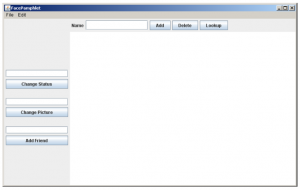The complete specification of assignment #7 can be found as part of the stream at iTunes.
Implement the FacePamphletCanvas class and complete the implementation of the FacePamphlet class
The class (which extends GCanvas) contains three public entries:
- A constructor that has no parameters. You can use this to perform any initialization you may need for the canvas. Note: depending on how you implement the canvas, it is entirely possible that your constructor may not need to do anything. It’s perfectly fine if that’s the case.
